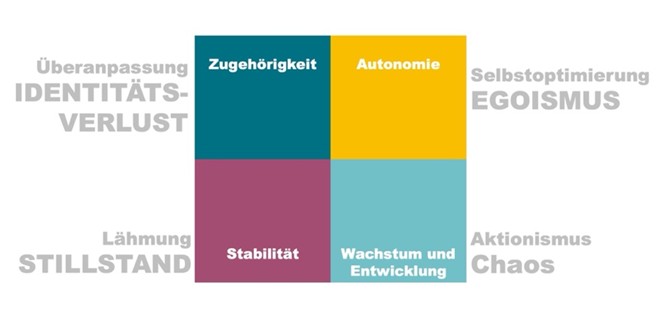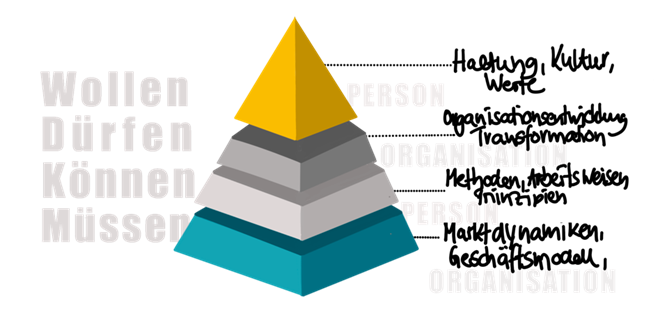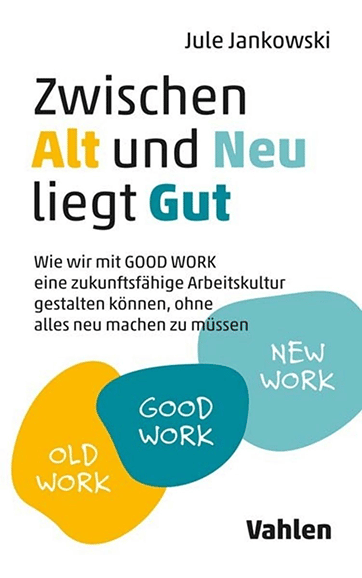GOOD WORK – Principles of good cooperation
New Work is on everyone’s lips. But what really moves people when they hear New Work, when they come into contact with it? Can the thought, the idea of a new world of work spark real enthusiasm?
The reality of New Work today: enthusiasm on the one hand meets rolling eyes and being annoyed on the other. For good reasons:
- What was originally designed by Frithjof Bergmann in the 1980s as a grand social utopia has in the meantime developed in large parts into a proper name without a concise core. Somewhere between self-determination, home office, fruit basket and agility, the phenomenon squeezes itself and increasingly creates disorientation.
- Perhaps it is also due in part to the little word “New”. To sensitive ears, the imperative to be “eternally new” may sound like a kind of mental eviction notice.
Quick reminder: new alone does not make anything better, let alone good. This good should be the focus when we talk about sustainable work culture, about GOOD WORK.
GOOD WORK as a moderating perspective on New Work
GOOD WORK¹ focuses on what works well, what is helpful, useful, purposeful and meaningful. It is about good cooperation and good results.
First and foremost, GOOD WORK is not another method hype, not a fashionable counter-design to New Work. It is a realpolitik view of how a sustainable work culture can be shaped. GOOD WORK starts where every company, every team and ultimately every person currently stands. What needs to be preserved? What needs to be adjusted? What do we have to say goodbye to? And where do we actually want to head?
GOOD WORK is based on the following five principles. They shed light on the design of a work culture that is equally suited to the people and the times and carries them into the future.
1. Successful relationship building
Questions: How do we connect, how do we build and strengthen a network of trusting relationships?
Essence: The principle of successful relationship building can be explored with the help of five aspects:
- Connection,
- networking and relationship (external, internal),
- understanding,
- connectedness and
- trust.
We need a widely ramified and at the same time stable network of relationships that is supported by trust. In this context, spaces for chance encounters and communication without premeditation are just as important as the intensive professional and trusting exchange in the narrower frame of reference. The mixture of both increases the quality of commitment within companies and is an identity-forming element for all those who see more in companies than just any employer.
Willingness to bond and bonding competence are future skills. The ability to give trust in a system, in a person, to show empathy, becomes a key competence in a networked working world.
Focus: networks, communication, interaction.
2. Flexible structures
Questions: What level of autonomy and flexibility do we need? How much structure does our system need? How can we achieve a balance?
Essence: Polycrises and increasing pressure to change demand a lot of flexibility from us. This trains and leaves its mark on people. They experience significantly more creative space and consequently claim more autonomy, also in shaping their everyday life and their work reality.
At the same time, the organising element of structures is needed to ensure stability and support.
In many companies, we can observe a struggle and balancing between autonomy and integration. Both aspects characterise an intrinsically human need, which, however, in its exaggeration leaves behind an empty organisational shell.
The current debate about working from home shows how challenging it is to find a balance between these aspects. This tension needs to be moderated through dialogue and distance from one-fits-all solutions. For example, company-wide, woodcut-like regulations on work location and working hours will lead nowhere. What is needed is a sensible discourse on, among other things, which work can be done best at which location and what added value the office of the future can provide. Here, relationship-building and the experience of genuine co-creation should be mentioned in the first place. Flexible structures are context-appropriate and adapt to the specific circumstances, demands and challenges of individual fields of activity.
Focus: Parameters, especially with regard to the organisation of work in terms of space and time.
3. Digital balance
Questions: Where do we move between analogue and digital? Is there also something beyond hybrid, perhaps digital-integral?
Essence: Digital balance as a principle comes into view, because it is about more than just the separation between analogue and digital. The image of “hybrid” is also misleading in some places, because it merely envisages the coupling of two separate states. Digital here, analogue there. Digital balance increasingly aims to integrate digital and analogue in a meaningful way and to make the transitions between the two very fluid, almost imperceptible.
This requires a high degree of digital competence and also includes the sovereignty to distinguish exactly when and where the digital sphere has reached its limits and where it can fully play to its strengths. One thing already seems certain: there will still be a need for purely analogue spaces in the future.
Another growth area of the digital balance is the importance of asynchronous, digital collaboration. It will presumably increase dramatically and challenge the belief that collaboration always requires synchronous coordination.
Hypothesis: The advance of the digital sphere will paradoxically lead to an increase in the added value of genuine encounters.
Focus: Attitude and competence in dealing with media and tools.
4. Lived agility
Questions: Agile principles² > agile frameworks. Again, agility is not an end in itself. Do we live the principles and apply them in a value-creating way or do we bluntly follow management hype?
Essence: The concept of agility is a bit like the phenomenon of New Work: it has become a fog word that covers up more than it offers concise solutions. And yet agility promises to offer a meaningful perspective on methodical, structured procedures for complex projects. Instead, we see a lot of misunderstandings, myths and, time and again, an exaggeration of methods and a belief in methods in the context of agility. Living agility overcomes this fixation on methods and focuses more on penetrating the principles contained in the various concepts and frameworks and applying them pragmatically. Four questions guide us through the relevant aspects of living agility.
- Do we have to act agilely?
- Can we work agilely?
- Are we allowed to work agile?
- Do we want to work agilely?
Focus: Methods and systematic ways of working.
5. Thinking in terms of possibilities
Questions: How do we recognise, use and pursue opportunities? How and on what do we meaningfully direct our joint action?
Essence: Thinking in possibilities would strictly speaking have to be supplemented by “acting” as a principle. The fifth principle of cooperation points the way towards the future and how entrepreneurial thinking and acting expresses itself in everyday coping. Especially where the space of possibilities seems to be limited to the maximum, it can be observed excellently how people and companies nevertheless start to shape things. The following regular sequence of steps can be seen here:
- Increased awareness, alertness for problems, challenges and opportunities in the environment that I/we want to and can address.
- Focusing on one’s own existing skills, networks, resources. Reversal from goal-orientation to means-orientation.
- Implementation that permanently looks at the axes “riding a dead horse” and “throwing everything away too quickly”.
- Vision. Every new project, every new initiative, start-up is attracted from the beginning by a thought, a goal, which is often not clearly expressed. A vision is not a static state and means more than a few strategic steps. Thinking in terms of possibilities means constantly aligning the next steps with the big picture.
- Purpose. The meaning and purpose of our actions – the purpose³ – is neither formed nor explored. It exists from the beginning. The challenge is to put it into words. The more we approach it through productive work, the better we succeed.
Focus: Entrepreneurial thinking, vision and purpose.
Ten ways for more GOOD WORK
So how does GOOD WORK work in practice?
- Create (analogue) spaces for intention-free encounters and exchange, even beyond team boundaries. Use the power of chance.
- Enable peer-to-peer learning and ensure informal learning, networking and a feeling of connectedness in a larger whole through cross-departmental and cross-hierarchical exchange – ideally also in small groups.
- Ensure a discourse on how much flexibility of space and time your organisation wants and can cope with. Formulate hypotheses regarding the benefits of flexible working models and reflect on this in regular cycles.
- Think less in quantitative terms (3:2 rule for home office) and more in qualitative contexts. What do we do best and where? For what do we need to be present?
- Shared presence days should be perceived as a value-added and meaningful exchange in the team and not as a silent disco where everyone dances to their own music, in their own tunnel. Videoconference-free times on team days can help.
- Don’t declare hybrid meetings the comfortable gold standard. They are the most demanding form of meeting format. Hybrid meetings, even more than any other meetings, require good preparation, a clear purpose, optimal technology and facilitation (preferably not by the executive).
- Discover the power of asynchronous digital collaboration. Working is much more than coordinating. Not every process step needs synchronous coming together.
- Methods are helpful, but not an end in themselves. Become sceptical if the focus in your organisation is too much on the right (!) application of the right (!) method. Rather, formulate action-guiding principles that are beneficial for your field of action and your culture.
- Go on a thinking-in-possibilities tour together. What tasks, what challenges do you see that exactly YOU, in your team, in your organisation can and should tackle? Turn the tables for once: Instead of “What are we still missing for this task?” ask yourself “What do we have, what can we do, who do we know to solve this task?” From goal orientation to means orientation.
- Last but not least, don’t lose sight of the next step in all your strategic efforts. The meaning is revealed in practical action, not in a workshop.
Notes:
[1] GOOD WORK was initially launched as a field research project in March 2020. Jule Jankowski wanted to record and evaluate the dynamics of the upheavals that occurred in the world of work against the backdrop of the pandemic. To do this, she conducted 100 interviews with people from very different contexts across the world of work. The result is the very popular GOOD Work podcast and a very interesting book, ” Zwischen Alt und Neu liegt Gut” (“Between Old and New Lies Good”).
[2] The Agile Manifesto defines 12 principles.
[3] Conny Dethloff has published an interesting article on the purpose of companies.
This is a best of blog post 2023.
If you like the article or want to discuss it, feel free to share it with your network.

Jule Jankowski
Jule Jankowski brings GOOD WORK to the stage, to the podcast and to companies in a variety of roles. With her consulting agency Humiq GmbH, the systemic organisational consultant accompanies teams and management teams in transformation processes on questions of cooperation and strategic orientation.
Her professional background is in the world of methods and insights. With a focus on empirical social research, Jule Jankowski’s career initially took her from the consulting industry to the corporate world. In her current professional work, she brings all these perspectives together: the analysis of social and psychological phenomena, methodological expertise and a focus on the essential: people.



